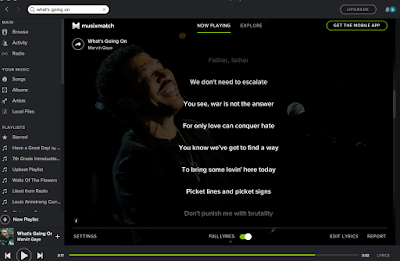"You see, war is not the answer/For only love can conquer hate..."
- Marvin Gaye
To end our discussion, we listened to "What's Going On?" by Marvin Gaye - his response to what was going on in the world in the late '60s and early '70s.
I'm a huge fan of Spotify (and one of these days I'll spring for a Premium account). A new feature they've added is the Lyrics tool (lower right hand of the screen when you've downloaded the desktop version):
Click on this link, and your main screen will switch to album/artist artwork and the lyrics to the song playing. You can decide if you'd like one line at a time, but I opt for the scrolling option so students can read just before or just after if they'd prefer.
Reading Marvin Gaye's words from "What's Going On?" Was a timely and such an appropriate way to end today's discussion, and I was glad to use this tool for my students as they reflected on when music and culture intersect.






.jpg)


